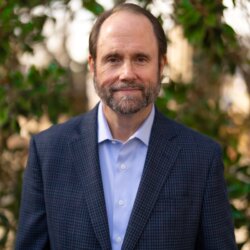
The light from a cross on a wall shines on a church's stage. © By ohsuriya/stock.adobe.com
Every day brings more evidence that the church in America and the Western world is on a path to imminent demise:
- Millennials are leaving by the droves.
- The number of Americans with no religious commitment is skyrocketing.
- Churches are dying all around us.
- The future of America looks far more secular than spiritual.
Every statement I just made is false.
Glenn Stanton is director of Global Family Formation Studies at Focus on the Family. He served the George W. Bush administration for many years as a consultant on increasing fatherhood involvement. He is the author of nine books and one of the most insightful commentators on American culture today.
In his new book, The Myth of the Dying Church: How Christianity Is Actually Thriving in America and the World, Stanton explores the best sociological research available today on the subject of religious commitment in America and beyond. What he discovers runs directly counter to the cultural narrative that insists that Christianity is in steep decline.
To the contrary, he finds remarkable good news for the gospel in our day. And he offers very practical advice for parents who want to help the next generation stay faithful to Christ.
Here are Stanton’s conclusions:
- Church attendance is at an all-time high, both in raw numbers and as a percentage of the population.
- “The percentage of young adults regularly attending evangelical and nondenominational churches has roughly doubled between 1972 and today.”
- The “Nones” (those who say they have no religious affiliation) are not new unbelievers but people who were never committed to the faith and now feel free to tell pollsters so.
- “The number of Christians in the world today is larger than it has ever been in the history of the world.”
Why religion matters
In the foreword, Baylor scholar Byron Johnson states: “There is indeed a dramatic decline among some American churches, but this severe decline can be found in a distinct group of churches found within theologically liberal mainline Protestantism.”
“On the other hand,” Johnson notes, “theologically conservative denominations (evangelical churches, Pentecostal churches, and especially non-denominational churches) are not in decline but are alive and well.”
Johnson then observes that remarkable good comes from religious activity, not only for the religious but for society as a whole. He cites a study indicating that religion contributes approximately $1.2 trillion to the US economy each year. Thus, “the strength and vibrancy of the church today has vast consequences, impacting personal and societal well-being for everyone.”
Nine out of ten Americans, whether part of a church or not, agree that churches are a wholesale benefit to their communities. Three-quarters say churches play a key and positive role in upholding and protecting morality in their communities.
Surprisingly, 81 percent of unaffiliated Americans and 75 percent of atheists say the church serves an important role in bringing people together and strengthening community bonds. Only 7 percent of American adults express mostly negative views about churches.
Countering the secularization thesis
Stanton contrasts these facts with the “secularization thesis,” which he defines as “the idea that modern life, cultural advancement, the abundance of material possessions, and the dominance of a scientific worldview inevitably translate into a culture where religion becomes increasingly irrelevant and relegated to the blue-hair pensioners and a few superstitious, anti-science hangers-on.”
A study conducted by two scholars, one from Harvard and the other from the University of Indiana, found: “Rather than religion fading into irrelevance as the secularization thesis would suggest, intense religion—strong affiliation, very frequent practice, literalism and evangelicalism—is persistent, and in fact, only moderate religion is on the decline in the United States” (their italics).
Examples:
- Believers who pray many times a day have increased more than 8 percent since 1991. Those who attend church services more than once a week rose slightly.
- Evangelicals have grown from 18 percent of the population in 1972 to 28 percent today. However, mainline Protestants have declined from 35 percent of the American population in 1972 to 12 percent today.
- The only religious group that has grown is those who were more robust and traditional in their beliefs and practices, increasing from 39 percent of all church attenders in 1989 to 47 percent in 2017.
Baylor sociologist Rodney Stark adds: the percentage of Americans who attend a local church (not necessarily weekly) has grown from 17 percent in 1776 to 34 percent in 1850, 51 percent in 1906, and 69 percent today.
The number of weekly attenders from all denominations has fallen from 44 percent in the mid-1950s to 35 percent today. However, nearly all of this decline is found in the liberal churches.
According to a Pew study, mainline Protestant churches declined by five million adult members between 2007 and 2014. However, evangelical churches grew in absolute numbers by about two million during this same time.
Nondenominational churches gain roughly five new members for every one they lose to religious switching. The nones are not coming from the more conservative Protestant churches. To the contrary, they are “folks who are simply being more honest and accurate in their description of where they have always been in terms of their belief and practice.”
Stanton concludes: “It’s the ‘nons’ [nondenominational churches] and not the ‘nones’ that are mushrooming.” He states: “There is simply no evidence that secularism is increasing in the United States or that faithful, biblical Christianity is collapsing. . . . The correct demonstrations of faith are growing, and the false ones are shriveling.”
I would add this observation: the secularization thesis is embraced by secular people and advanced by secular media because it advances their secular worldview and agenda. If evangelicals are not diligent in countering this narrative and advancing God’s kingdom, it could become a self-fulfilling prophecy.
Why liberal churches are declining
Stanton notes that “nearly all the decline in Christian identity and church attendance is in the more liberal mainline denominations” (his italics). Referring to the growth of conservative churches, he offers these reasons:
- Conservative churches take evangelism and salvation seriously, thus leading their members to reach others.
- They tend to develop more dynamic programs for children and teens because they are concerned about their salvation.
- Their worship is more vibrant and authentic because they believe God has forgiven their sins and given them new life, so they respond in gratitude.
A Canadian study concluded: it is “clear that theological conservatism plays a role in distinguishing growing from declining mainline Protestant churches.”
The health of the global church
Philip Jenkins is the author of fourteen books and one of the leading experts on our subject. He expects the global Christian population to grow from two billion to three billion over the next two decades. In his view, Christians will be the world’s largest faith for at least the next eighty years.
According to Stanton, Christians are “leading an epochal cultural revolution.” This growth is primarily in the Global South. By 2025, half of all Christians will live in Africa and Latin America. Three-fourths of all Catholics will live in Africa, Asia, and Latin America.
Gordon-Conwell’s Center for the Study of Global Christianity (CSGC) tracked growth from 1970 to 2017, with these results: a 408 percent increase in Africa; a 324 percent increase in Asia; a 124 percent increase in Latin America; 71 percent growth in Oceania; and 37 percent growth in the US. According to Jenkins, this growth is clearly and strongly conservative, traditional, and spiritually dynamic.
For example: There are more new Anglican churches in Africa than in the United Kingdom. They have more seminaries as well. The number of Catholic men preparing for the priesthood in Africa has grown from just over two thousand in 1960 to over twenty-seven thousand in 2011.
Ninety percent of Nigerians attended church last week; 71 percent (on average) in sub-Saharan Africa attend church weekly. Rodney Stark says a “seismic religious shift” has happened in Southern Africa. In addition, there are more Chinese citizens pledged to Christianity than to the Communist Party. Some local Chinese Christians estimate believers to number well more than one hundred million.
Why such growth?
- Christianity adapts well across cultures. Unlike Islam, for example, it does not require changes in dress and geographical allegiance. Asian converts remain Asian; Irish converts remain Irish.
- Conservatives are more committed to evangelism. Less than 4 percent of all missionaries are sent by the more liberal, mainstream churches.
- Conservative Christians tend to have more children. By 2055, only 9 percent of all births will be to parents with no religious affiliation, while 36 percent of babies will be born to Muslims and 35 percent to Christians.
Youth and the future of the church
We hear constantly that young people are leaving the church in record, catastrophic numbers. The truth is, teens and young adults have always tended to be less faithful in religious participation than their parents. This was true in the biblical era, the Reformation, and today.
However, it has also been true that when they marry and have children, they become more regular attenders.
According to the General Social Survey (GSS) conducted by the University of Chicago, we are at the highest reported levels since 1972 of regular church attendance among eighteen to twenty-nine-year-olds. The percentage of young adults who self-identify as evangelicals doubled from 1972 to 2016, the last year for which GSS has data.
Young evangelicals are staying as conservative as their parents on social issue or becoming more conservative, according to Byron Johnson.
Pew reports that of all those who left Christianity as adults, only 12 percent reported having any kind of strong or serious faith when they were teens. Conversely, nearly 90 percent of kids who came from serious Christian homes carried their faith into adulthood.
In fact, according to Stanton, “85 percent of teens raised by parents who took their faith very seriously, and lived in a home with consistent faith practices, became young adults who not only had a serious faith, but had the highest levels of religious belief and practice among their peers” (his italics).
In other words, parents who model their faith at home is the most important factor in their children’s faith experience. What matters is that faith matters to us, whether we live it perfectly or not.
Relational closeness is also vital: children who feel close and secure with their parents who are faithful Christians are at least twice as likely to have a more passionate and personal faith.
Stanton offers these practical suggestions:
- Help children learn to pray and read Scripture for themselves. Praying through the day, not just during a “quiet time,” is an important model for them.
- Enjoy the study of Scripture and talk about its relevance to life situations.
- Help children learn to see and experience God working in our everyday lives. “Who can I be a blessing to today?” is a good question for them to begin asking themselves.
- Look for and celebrate God’s miracles in our world and lives. Read stories about miracles in the saints and Scriptures. Celebrating answered prayer is very reinforcing for children.
- Encourage our children to be honest about their doubts. Help them find answers for themselves.
- Help children pay a price for their faith, as this reinforces their commitment to Christ.
- Invite other adults to help our children grow in their faith. They are known as “scaffolding” (they help build and hold up the children) and “satellites” (they orbit them regularly).
What is the future of the church?
According to a study in the Journal for the Scientific Study of Religion, only 1 percent of church congregations in the US die every year.
Consider Young Life as one example of ministry to youth. In their weekly clubs, US attendance increased 31 percent from 2009 to 2017; overseas, attendance increased 416 percent. Young Life’s weekly leadership studies have grown 69 percent in the US and 620 percent internationally. Schools reached and impacted by Young Life groups increased 73 percent in the US; the number of volunteer leaders increased 94 percent in the US and 265 percent overseas.
InterVarsity is a ministry focused on colleges and universities. The overall number of their chapters on college campuses has grown 14 percent in the last five years. The number of students and faculty is up 35 percent over ten years ago. Faculty member involvement is up 48 percent over 2007.
The number of students who came to Christ through InterVarsity outreaches increased 36 percent over the last five years and 130 percent since 2007. In 2017, they reached their highest number of new Christians ever.
Scholar George Marsden has written of “a renaissance of Christian higher education in the United States.” He says Christian universities are getting larger, more numerous, and better.
Other facts: Christians seeking faith-based content from radio, television, and the internet increased 22 percent around the world from 2000 to 2017. According to the CSGC: the number of Christian book titles sold internationally increased 83 percent from 2000 to 2017. The number of Bibles printed and distributed internationally increased 63 percent from 2000 to 2017.
The CSGC reports that evangelicals grew 43 percent from 2000 to 2017; Pentecostal/charismatic churches grew 45 percent; independent churches grew 45 percent; Protestants in general grew 32 percent; Roman Catholics grew 20 percent. The number of nondenominational churches increased 56 percent from 1998 to 2012.
Giving to local churches increased 177 percent from 2000 to 2017 and presently stands at $360 billion. Giving to parachurch organizations increased 184 percent to $540 billion. Total giving to all Christian work internationally increased 181 percent, presently at $900 billion.
And no era in church history has experienced so many megachurches. Over a five-year period, only 17 percent experienced any kind of decline; 13 percent increased 100 percent or more. And 64 percent report an increase in young adults attending their churches in the last three years.
Conclusion: The power of the Holy Spirit
To summarize: The church is shrinking—if we’re focusing on mainline, liberal churches. The number of “nones” is increasing—except they never had a real faith to begin with.
The most important factor in the health of the church today, however, is not found in statistics and trends. In fact, Stanton calls our last topic “more central and foundational than any other in understanding why the church is not dying and indeed, cannot die.”
This factor: the Holy Spirit.
The Holy Spirit is the giver of life (Genesis 1:2) and new life (John 3:8). The Nicene Creed states that the Holy Spirit is “the Lord, the giver of life.” He cannot not give life, for this is his very essence and nature.
Thus, the church cannot be dying, for he cannot let it be so.
Stanton notes that the Spirit’s coming at Pentecost “formed Christ’s church” and “sent the history of the world in a new direction.” In fact, “the Holy Spirit is the most powerful force in the universe. Thus, so is the church that He empowers.”
Jesus will be with his church “always, to the end of the age” (Matthew 28:20). There will be a “great multitude that no one could number” in heaven (Revelation 7:9).
Thus, God cannot and will not let his church die. To the contrary, we will attack hell and hell cannot defeat us (Matthew 16).
I would add that this fact helps explain the decline of liberal churches: the Holy Spirit cannot breathe life into and through them because they are being disobedient to the word of God.
The churches that are declining are churches that Jesus cannot bless because they are not “teaching [their members] to obey everything I have commanded you” (Matthew 28:19) and because they are not assaulting the gates of hell.
If we will live and teach Scripture and attack hell by taking Christ to our culture, we will have Jesus’ presence and power.
And we will win.













